The Best Kind of Kayak for Yotties
In our previous article we listed lots of jolly good reasons for carrying a kayak aboard your yacht. But kayaks and canoes come in all sorts of shapes and sizes and can be made from all sorts of different materials. Which sort is best for carting about while you sail?
Canoe or Kayak?
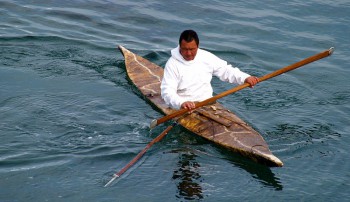
To begin with, let’s sort out the nomenclature. What’s the difference between a kayak and a canoe? When I was a kid, whatever shape they were and however you paddled them they were all called canoes, and when I first heard it I thought that kayak was some “fancy” American word. As it turns out, they’re both American words in the broadest sense. Canoe was the word which the Carib Indians used to describe their dug-outs. Dug-outs are paddled using a short single-bladed paddle, and so any similar, open craft which is also so-propelled is known by this name. This includes the birch-bark creations which were used in northern North America and which are the role model for most modern canoes.
Kayak, meanwhile, is an Eskimo word. The Eskimos’ vessels were made from sealskins stitched over a whalebone frame, and they were usually propelled using a two-bladed paddle. They were seaworthy craft, for whereas canoes are generally used only on inshore tropical waters or on rivers, the Inuit and the Aleut et alia paddled themselves out amongst the ice, navigating safely through icy cold and relatively rough water. In fact, the native hunters even invented the spray-deck – a skirt which fits around the wearer and laces to the rim of the cockpit, so blocking the ingress of water. They also perfected the roll, whereby a kayaker, having capsized in the surf, quickly flicks himself and his vessel upright again.
The Eskimo are said to have been using kayaks for at least 3,000 years before Eric the Red rocked up (in 1,000 AD), and they were still using them in the 1950s when some clever gringo saw a kayak and said, “Hey, I could make those – in fibreglass!” As you can see if you look at the photo, the native hunter’s kayak was the direct inspiration for the vessel which is now used all over the world; so there’s really no question about what these modern craft should properly be called.
Trad v Sit-on-Top
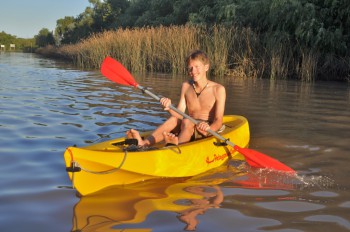
A kayak is much more suitable than a canoe for paddling in the sea, and it tends to be a lot smaller. So, a kayak is what you want – but the field of choice is still broad. Kayaks come in all sorts of shapes, from the traditional Eskimo-style craft all the way up to a long, thin thing designed for racing, and all the way down to a short, flat object which looks like a shoe. One thing that these extreme types have in common is that they are both rather unstable. And the racing machine won’t fit on your deck; and the white-water kayak won’t accommodate an extra passenger and your picnic.
So we’re looking at a middle-of-the road kayak – but even here we still have plenty of choice. For starters, you’ll need to decide whether you want the traditional sort of vessel or a sit-on-top.
Sit-on-tops were the natural progression after designers started to produce plastic kayaks. Unless you’re using a cloth spray-deck, the traditional style of kayak leaves the paddler sitting in a puddle – but most people messing about on the river or at the beach don’t want the inconvenience of a nylon skirt. Looking to popularise the sport, the designers therefore looked for another way to keep the water out of the cockpit; and the solution was to do away with the cockpit. The sit-on-top is a sealed unit, and any water which lands aboard it drains away through four large holes.
Size and Stowage
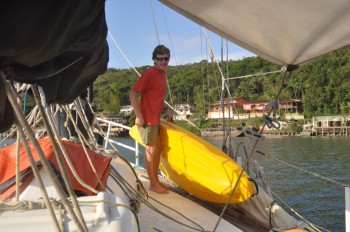
Unless your boat has large amounts of deck space you’ll want to go for the smallest kayak that you can get away with. I once saw a catamaran with four touring kayaks lined up across the foredeck, but I think the owner must have been cruising to kayak, rather than the other way about. For most of us the sailing adventure is the main thing. If you still want to be able to pace the decks, and if you don’t want to be forever untangling the genoa sheet from your new toy, you’ll opt for something which is no more than 3 metres long (10 feet). If you’re planning to keep the kayak in davits then you can go for something a bit longer, but I would recommend that you don’t make it any longer than the maximum beam of your yacht. Otherwise, one day when you’re coming alongside a quay… you’ll trash it.
Bear in mind that kayaks shorter than 3m/10ft are apt to be chubbier. In order to support your weight they still need to have the same volume, and so they’re generally beamier and deeper. This means that they’re “fatter” to stow on your side-deck. They’re also slower to paddle and harder to keep on course.
If you’re petite, or if you’re buying a kayak for a child, then you can get away with something which is short and slim by virtue of being less buoyant – but if you want the whole family to be able to use the thing, be sure to check the rating before you buy. This kayak, for example, has great appeal as a pocket-paddler because it’s just 2.65 metres long, but it’s only rated for a total cargo of up to 85 kilos. This probably rules out the idea of Dad, in the extremis of the moment, paddling off with the storm anchor and 50 metres of warp.
Plastic v Deflatable
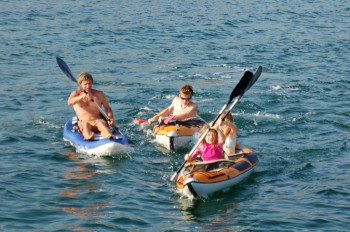
If you’re fond of DIY then you might fashion your own kayak from plywood – or, I suppose, from canvas stretched on a wooden frame – but if you want something which is available off the peg you’ll go for fibreglass or plastic. Fibreglass appeals, in as much as it is relatively easy to mend, but plastic kayaks are cheaper and lighter (and you won’t often find a fibreglass sit-on-top).
If your boat is small and space is at a premium you could consider buying an inflatable kayak. An inflatable will fold up and fit into a bag the size of a large suitcase, so you can probably stow it in a cockpit locker or under your bed. Inflatables are also lighter than the solid kayaks – but the well-made PVC and cloth-covered ones are not so much lighter as one would expect.
Inflatable kayaks come in all sorts of shapes and sizes, and we’ve now owned three different kinds. We are also now the owners of a polyethylene sit on top made by Patagonian kayaks. Thus, we have had the opportunity to compare and contrast at great length, and the rest of this article is devoted to our conclusions.
The three inflatable kayaks depicted in this photo are a very nice one-man kayak, with an aluminium frame in the bow and stern; a two-man inflatable from the same manufacturer; and a one man sit-on-top. (If you’re wondering why I haven’t linked to the manufacturers’ websites, it’s because they’re no longer in production – but here is something similar; and here is something that you really don’t want to get involved with – unless you’re happy with a beach toy.)
Whilst the sit-on-top was the best fun for games of water-polo and such like, it was a lot slower than the other two and it didn’t track (keep on course). The two-man kayak had the most use as it could be paddled either solo or with a companion – and when it was used two-up it was impressively fast. The one-man inflatable, with its rigid bow and stern, is quite a fancy piece of kit and goes along very nicely, BUT – and here we come to the downside of inflatable kayaks – it only goes well when it has been freshly pumped and is perfectly rigid. Moreover, in order to get it into a state of perfect shapeliness one has to muck about for an hour beforehand, finding and unfolding the thing, assembling the pieces which wedge into the bow and stern, and then pumping the tanks in the appropriate sequence.
Convenience
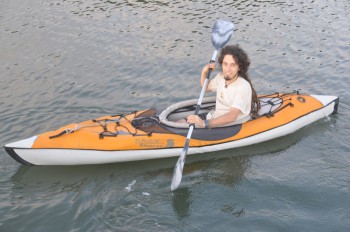
The more sophisticated your inflatable kayak, the faster it will be and the better it will track, and the more hassle it will be to put together. When Nick cast off the dinghy without checking to see that the oars were aboard it took us just seconds to launch the new plastic kayak whereas by the time we’d got the one-man inflatable out from under the bed and put it together he would have been half way to Argentina.
What blows up must come down again – and when we’ve finished with the inflatable kayak it has to be thoroughly rinsed in fresh water and then thoroughly dried and carefully folded. If it’s not rinsed it stays salty and damp; if it’s not dried it goes mouldy; and if it’s not carefully folded it won’t fit back into the bag or the locker.
Admittedly, having a solid plastic kayak lying around on the deck is not always terribly convenient, but at least it isn’t such a time-waster.
Strength
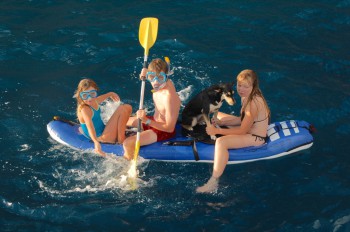
Of course, we don’t deflate the blow-up kayak every time we finish with it. We just lift it out and lie it on deck beside its plastic cousin. Then we tip out the water; we lash it to the rail (in case the wind gets up), and we cover it (to protect the cloth from the sun); and then – most important of all – we let out some of the air. If you don’t release some of the air then when the day warms up, and air expands, your kayak will burst. That’s how we wrecked the two-man inflatable pictured in these photos.
I was so precious with that kayak! Whenever anybody I used it I stood over them, checking to see that they drained it, covered it, let out some air… Nag, nag, nag. If we left it sitting on the water we would always turn it upside down to protect it from the sun. And then one day I forgot, and an hour later I glanced astern to where I’d left it sitting, and saw a thing that looked like a long-dead dolphin’s swollen carcass. The PVC air bladder was still intact, but the terylene outer cover had burst, allowing it to stretch out of shape.
Besides being careful always to let some air out of the kayaks after use I was also very concerned to see that nobody got aboard with sandy feet – because sand working its way between the inflatable floor and the tank is bound to abrade the plastic. I also nagged everyone about overloading these fragile boats; but, of course, they didn’t listen. That’s how we burst the inflatable sit-on-top, during the Canoe Wars. With Roxanne standing on the seat and a French friend on either end, it was bound to happen.
In conclusion, we had thought that our inflatable kayaks were a way to have something for nothing: the way to have kayak without adding to the deck-clutter. But having now owned them for several years we find that the bad points outweigh that one single good point. We still have one surviving inflatable kayak, but during the past two years it has only seen the light of day on two occasions. It’s just too much hassle.
Plastic Fantastic
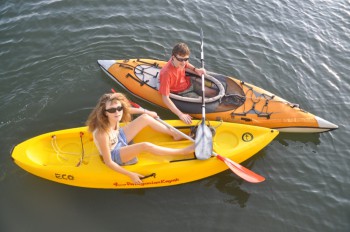
I hate plastic. But, then again, the inflatable kayak is also made from plastic, albeit in a different form. In fact, the bladder of an inflatable kayak is made from PVC and the creation of this type of plastic does far more damage to the environment that the manufacture of polyethylene.
When all is said and done, polyethylene plastic is fantastic stuff in the right place. Its use in the form of bags, wrappers, bottles, and such-like is criminal, but when used to create something which will endure indefinitely it probably causes no more environmental bad karma than plywood or fibreglass.
Of course, my new kayak will only endure indefinitely if it’s covered up. Left lying around all day in the tropical sun, a plastic bucket lasts for only a couple of years, and a plastic kayak would probably show signs of suffering within that same time. However, I can deal with this minimal amount of hassle. And having once owned a polyethylene Topper I know that it is not true that things made from this material cannot ever be repaired. To be honest, they seldom do need repairing, because a plastic hull is pretty tough, but when they do you simply melt some more polyethylene into the crack using a hot-air gun.
The plastic sit-on-top which we chose is a rather shapely one, with a good sharp V at both the bow and stern enabling good entry and good tracking, and plenty of beam to make it very stable.
Called the Eco, it’s not the smallest one offered by this particular company, but because it’s rated for paddlers of up to 130kgs – and because I weigh only 55kgs – I find that I can carry extra cargo in the form of a child or a dog (or both). And there would certainly be scope for the skipper to get aboard with the 55kg fisherman anchor or a hefty mooring warp. Indeed, I can see the kayak proving very useful when we are in down at the tip of the American continent, in the land from which the company takes its name.
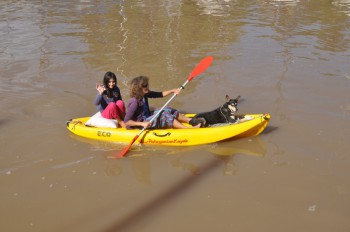
The company also make a two man kayak which measures 3.65m. Paddling two-up is fun for a mother and child combination but be advised that siblings, even when they are the best of friends do not always cope very well in a kayak. Paddling in a co-ordinated manner requires that at least one crew member have the maturity to accept the other person’s pace.
Most plastic sit-on-tops have small foot-rests which are moulded into the hull, but the Eco has generously-sized sliding foot-rests which allow the paddler to push hard. Fitted to a track, they can be adjusted to the optimal position by each paddler. Another feature to look for when choosing a kayak is a handle at either end, for ease of carrying. Our new toy also has handles amidships, and we’ve found that if the paddler stands on the outer edge of the kayak, thereby tilting it to 45 degrees, one of the stronger crew members can actually lean over the rail and pick it up with one hand. This saves the usual hassle of banging the thing on the topsides as you lift it from either end. Well thought out details such as this make all the difference.
Unlike other sit-on-tops which I have tried, this one is also remarkably dry. With a closed-cell foam cushion over the holes I don’t even get a damp seat. Of course, not everybody cares about that sort of thing; some people take their sit-on-tops into the surf. The Eco is supposed to be rather good at that sort of thing, but I haven’t plucked up the courage to try it yet.
Conclusions
When it comes to kayaking I’ve found that nothing beats the care-free convenience of a lump of polythene. My new sit-on-top spells quick and easy independence and I look forward to many years of exploration, exercise, and all round fun.
